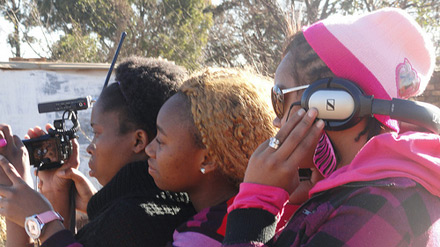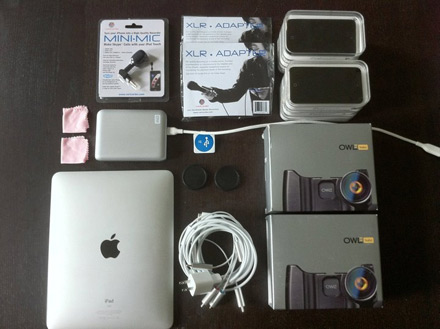
Mobile journalists, or “mojos,” in training. (Credit: Allissa Richardson/Flickr/Creative Commons License
On April 19 to 20, more than 300 journalists from around the world descended on Austin for a sold-out conference on online journalism. The International Symposium of Online Journalism, hosted by the Knight Center for Journalism in the Americas at the University of Texas at Austin, featured a host of new media gurus discussing everything from “mojos” to data visualization. A selection of takeaways:
Don’t focus on building your own online community; insert your site into already established communities.
Deseret News, a Mormon owned news brand “for faith and family oriented audiences in Utah and around the world,” has grown its social media presence and views exponentially in recent years. The secret, according to Clark Gable, president and CEO of Deseret Publishing Company, was “finding the conversation people were already having” and then inserting their content into the flow.
The first step to being able to do that, Gables said, is to determine your publication’s unique niche (in the case of Deseret News, family values are high on the list). He emphasized that, in an online realm, it should be about what you are best at not only in your own community, but also in the world, since your audience is not limited by geography. “If you don’t know what you’re going to be good at,” he said, “you don’t know what the conversation is going to be.”
Gables provided Forbes and The Atlantic as two brands that have excelled at identifying what they are best at and then inserting their brand into existing conversations.
Data teams are on the rise, as is the demand for people who know how to manipulate and visualize data.
Data was hot at the symposium, just as it was at the Online News Association’s conference last fall. Jennifer Carroll, senior editor and VP for content at Gannett, said her organization is expanding its data staff. Investigative News Network, in partnership with Investigative Reporters and Editors, is also hiring a data reporter.
At the Texas Tribune, databases — particularly of public employee salaries — have been one of the site’s greatest successes, said John Thornton, the paper’s chairman and founder. In a talk with Latin American journalists, Thornton said that came as a surprise — calling it data “porn.”
Figuring out how to not only manipulate large data sets but also display them visually was another theme. Kim Rees, partner and head of data visualization at Periscopic, shared a stunning and devastating visualization of the number of Americans who have died due to gun violence, along with the corresponding years of lost life.

Screen capture of interactive data visualization produced by Periscopic.
University of Miami Professor Alberto Cairo summed up the value of graphic literacy to digital journalists this way: “Friends don’t let friends use pie charts.”
Engagement is not clicking a “like” button.
NPR’s Andy Carvin opened his talk about online engagement by sharing how social media gets things wrong. He started with his own experience tweeting erroneously about former Congresswoman Gabby Giffords’ death.
“How often do we post reports without a third source, or even a second one, to back it up?” Carvin asked. “How many of us have typed up a tweet for a major news Twitter account and hesitated before hitting the send button, wondering, what if we’ve screwed this up? And how many of us have hit the button anyway?”
The role that journalists can play in social media, Carvin argued, is a two-way street of helping the public “become better consumers and producers of information — and hopefully achieve their full potential as active participants in civil society.” Crucial to that, he said, is being transparent about what we know and what we don’t know, actively addressing rumors that are circulating online, and challenging the public to scrutinize them:
“Why aren’t we engaging the public more directly? I don’t mean engagement like encouraging them to ‘like’ us on Facebook or click the retweet button. That is not engagement. By engagement I mean, why don’t we use these incredibly powerful tools to talk with them, listen to them, and help us all understand the world a little better? Perhaps we can even use social media to do the exact opposite of its reputation – to slow down the news cycle, help us catch our collective breaths and scrutinize what’s happening with greater mindfulness.” Read the full transcript»
The question of how to create meaningful engagement was also the focus of an award-winning academic study, “40 Million Page Views is Not Enough: An Examination of the Christian Science Monitor’s Evolution from SEO to Engagement.” One of the paper’s authors, Jonathan Groves, a professor at Drury University, noted that at the Monitor they were getting high traffic, but not for their award-winning — and expensive — international coverage (Disclaimer: I reported from Spain and Germany for the Monitor). Instead, the uptick tended to come from national coverage and polls. Groves, who authored the paper with Professor Carrie Brown Smith at the University of Memphis, concluded the problem was primarily that the Monitor was conducting a one-way conversation with its readers and needed to find better ways to meaningfully engage them.
“Mojo” is on the rise.
Another focus of some conference presenters was on how to use mobile low-cost tools to train journalism students — and residents — to become “mojos,” or mobile journalists, so they can report their own stories.
Ivo Burum, a former Australian Broadcast Company reporter, has been working with indigenous aborigines and other marginalized communities, training them to report their own stories using mobile video techniques. He said that the equipment costs are under $400 a person, and some participants have gone on to be paid correspondents for broadcasting companies. “At the end of four hours everybody has a video,” Burum said. “They can’t believe it.” An editor from a Danish tabloid newspaper, Ekstra Bladet, was so impressed with the technique that now Burum is training reporters from the newsroom and developing a web television presence with them.

A mobile journalism rig. (Credit: Allissa Richardson/Flickr/Creative Commons License
Alissa Richardson, a professor at Bowie State University, is teaching similar mobile techniques to all of her students and to young people from at-risk backgrounds. She also trains girls abroad in conjunction with Global Girls media.
Forget J-schools as teaching hospitals; think entrepreneurial models.
David Ryfe, a professor at the University of Nevada-Reno, shared findings from a paper he wrote with his colleague Professor Donica Mensing on the concept that journalism students can help fill the void in local reporting. The paper, which also won an award at the symposium, explained that the difference between this model and a teaching hospital is that doctors are “committed to a profession that will reward them when they’re done in terms of prestige and income.” Journalism is not that today. Instead, the “newspaper industry is imploding,” and this model “sends people to fill in the gaps left behind.”
Ryfe urged educators to pivot away from a professional model that no longer exists and to examine new models instead. Students can do work for publication, but it should focus on experimentation rather than transferring the legacy newsroom to the university. Echoing a recurring theme at the conference, he also noted that the skills learned in J-school can be used elsewhere. A good point,, but if you happen to be paying for that journalism education, those are very expensive auxiliary skills.
















